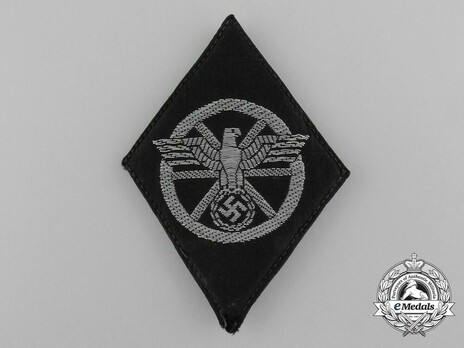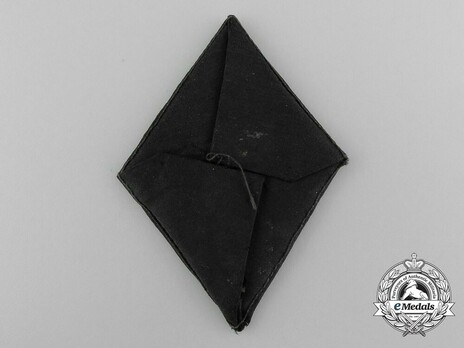NSKK Driver Sleeve Insignia (2nd pattern machine-woven eagle)
CATEGORY: Version
SKU: 53.GOR.03.02.05.003.002
Estimated market value:


Estimated market value:
In metallic threads; machine woven BeVo style on black fabric base; measuring 68 mm x 50 mm; near mint condition.
The NSKK (Nationalsozialistisches Kraftfahr-Korps = National Socialist Motor Corps) was a paramilitary organisation affiliated with the NSDAP, specialising in anything related to the driving of motorised vehicles. NSDAP officials recognised the need for access to cars and trucks for both transportation and propaganda purposes as early as 1922, and certain steps were taken to ensure this need was met. However, it took until April of 1930 for a specialised motor organisation to be officially founded. This organisation was named NSAK (Nationalsozialistisches Automobil-Korps = National Socialist Automobile Corps), but was renamed to NSKK less than 13 months later.
Initially, the NSAK/NSKK was under the control of the SA and existed next to its parent organisation’s own driving-related sub-organisation, the Motor-SA. This changed after the “Night of the Long Knives”, in which many SA leaders were purged and the organisation was substantially disempowered. After July of 1934, the NSKK became an independent organisation whose leader, NSKK-Korpsführer Adolf Hühnlein, answered directly to Adolf Hitler.
The main tasks of the NSKK were to provide transportation for all organisations of the Third Reich, to train and instruct boys and men (and a number of women) in mechanics and driving, and to assist police in regulating traffic. During the mid 1930s, the organisation also provided roadside assistance.
With the onset of the war, the NSKK’s tasks underwent certain changes. Instructing both civilians and soldiers in the driving and maintenance of armored vehicles became a higher priority. The NSKK also began working closely with other organisations, for example Organisation Todt (OT), by providing transportation of workers and supplies for the colossal building project that was the fortification of Germany’s Western border, the Siegfried Line (or Westwall). During the war, the NSKK provided much of the transportation needs for the German Army and the Luftwaffe, including the transport of troops, weapons and ammunition, and building materials, for example for the construction of air bases in the newly conquered territories in Eastern Europe after the attack on Soviet Russia in the summer of 1941.
Parts of the NSKK would come under the control of architect Albert Speer who took over OT after the death of Fritz Todt in 1942, leading to the creation of Transport Brigade Speer (later Transport Corps Speer), which would eventually completely sever its ties to the NSKK.
The Driver Sleeve Insignia was initially used as a membership insignia worn by all NSKK members on the lower left sleeve. This was changed around the time of the beginning of the war. From this time on, it was worn only by those with a valid vehicle operator’s licence.
There are two patterns with only a slight difference in design: the 1st pattern features an eagle with pointed wings, while the 2nd pattern features an eagle with squared wings. In both cases, the eagle is superimposed over a wheel with spokes, eight for the 1st pattern, and six for the 2nd pattern. Eagle and wheel are silver-coloured, either made of metal (1st pattern only) or machine-woven/embroidered, and the cloth backing is in black and in the shape of a rhombus or “diamond”.
The 1st pattern eagle for Officers was usually machine-woven, while lower ranks used a metal eagle. The 2nd pattern eagle for Officers was usually hand-embroidered, while lower ranks now used a machine-woven eagle.
NSKK leader Hühnlein wore the insignia with twist cord piping, and his successor, Kraus, wore a carmine insignia.
The winners of the annual NSKK driving competitions wore black and white or silver and white twist cord piping for the year of their victory.

Comments
Sign in to comment and reply.


Scroll Top